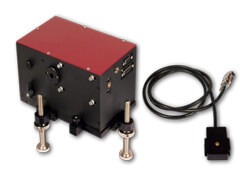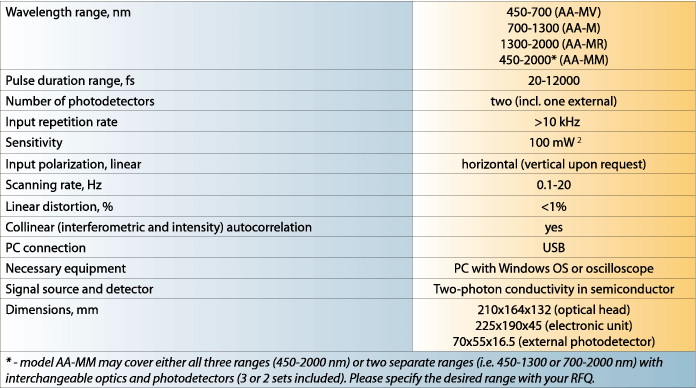AA-M real-time USB autocorrelator for microscopy
Pulse duration range 20 fs – 12 ps
Wavelength range 450-2000 nm
External detector for sample position measurements
Internal detector for input control
Bypass switch
Linear distortion less than 1%
Fringe-resolved autocorrelation function
USB connection and PC software

1. General
If you work with ultra-short femtosecond pulses in microscopy you might already know that dispersion introduced by microscope’s optics can seriously broaden your pulse thus substantially decreasing the efficiency of nonlinear imaging techniques. Moreover, broader pulses require more pulse enegy to get the same image as with the shorter ones, while higher average powers can burn the sample. The AA-M real-time autocorrelator with an external photodetector allows monitoring of pulse duration at the very sample position of a microscope or other optical system.The system also has a second photodetector that is placed right before the microscope’s input for pass-through comparative measurements. This lets you precisely control the imaging process and get the highest non-linear conversion efficiency possible with your laser system. Even on the step when you are considering what system to buy you might opt for the system with shorter pulse duration knowing you can harness it after your optical setup. The AA-M main unit has a bypass switch for the laser beam to pass through untouched.
The system offers 20 fs to 12 ps pulse duration measurement range with >30 ps scan range to cover different systems you might have in your lab, not only those that need dispersion control. In addition to showing the AC, intensity traces and calculating the final FWHM pulse duration in real-time,the unit provides Gaussian and sech^2 fitting options and data storage and export. The statistical viewer feature allows comparison of different measurements. While the unit boasts USB connection and acquisition/analysis software included into the default package, the oscilloscope can also be hooked up to the unit to see the raw AC trace if a PC is not around.
The wavelength coverage of the unit is divided into three ranges: 450-700 nm, 700-1300 nm and 1300-2000 nm, each being covered by a relevant exchangeable photodetectors/beamsplitter set. The standard AA-M comes with one photodetectors/BS set for the desired range pre-installed and not exchangeable, while the AA-M-M modification allows seamless interchangeability of the detectors/BS sets and coverage of two or all three different wavelength ranges.
You might also consider our APC pulse stretcher/compressor to introduce negative dispersion to your pulse before inputting it to your microscope or control the pulse duration of a femtosecond laser.
2. Specifications
3. Modifications
-M – this mode enables the exchange of photodetector units/BS, allowing you to cover two or all three available wavelength ranges with one device.
-LP – long pulse version of the device, increases the input pulse duration range to 20 fs – 30 ps.
-LR – low input repetition rate limit, the rep rate requirement becomes >10 Hz.
Note: -F, -M, -LP and –LR modifications can be combined in any way.
4. Applications
Femtosecond pulse duration measurement at sample position of a microscope
Determining dispersion of optical setups and microscopes
5. FAQ
Q. How long does it take to swap the photodetector/BS pair in the AA-M-M unit to cover a different wavelength range?
A. The procedure takes around 15 to 20 minutes and simple calibration is only necessary after the swap.
Q. How close can I get my microscope’s objective to the external photodetector surface and can I use oil and water with my inversion objectives?
A. The limit for a standard unit is 200 um for inversion objectives. Oil and water are also permitted on the surface of the photodetector, just be sure to clean it according to the user manual. If you need to get closer please let us know so we could offer a customized external photodetector.
6. RFQ Hints
Just some quick hints before you send us an RFQ:
1. Choose the right wavelength range for your application: 450-700 nm, 700-1300 nm or 1300-2000 nm. Two or all three ranges can also be covered with the AA-M–M modification.
2. Send us the specs of your laser system (rep rate, wavelength, pulse duration, average power) so we can check if the AA-M is the right choice for you.
3. Decide if you need one of other modifications (see modifications tab).
